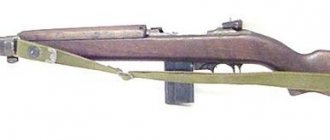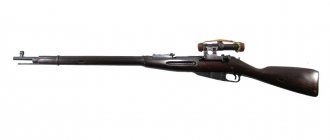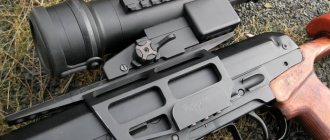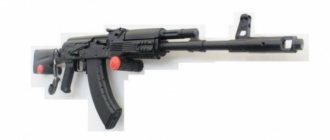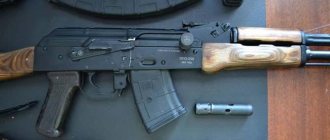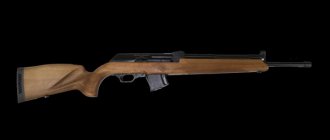With a carbine in his hands. M1 Carbine (part 1)
I have always advocated that you should write about what you know well. Or what you read about in different sources (the more there are, the better!), or about what you have been doing for a long time, that is, in fact, you are receiving a second (third) higher education.
For example, tanks... I made the first model in 1980 and then made them for 10 years, then I started writing about them and publishing my own magazine, then the first books came out, which were reviewed by good experts, and so on for 38 years. It is clear that I will not start a tank. But as for their history and technology itself, I know them quite well.
Small arms, so to speak, have been given less time, only six years, since my first articles about them appeared in 2012. But if a person is given a second higher education diploma after three years of study in the Armed Forces with an already existing first education, then six years seems to be enough? However, I can say that in theory - yes, but in practice it is advisable to hold on to each sample yourself, feel its weight, convenience - “handiness”, disassemble - assemble. Ideally, you can also shoot with it, but in Russia this is an unaffordable luxury for the vast majority of authors. That’s why I’m especially happy when a friend of mine, who collects various small arms, calls me and tells me that another sample is waiting for me to “hold on to.”
This time the M1 carbine became such a model. By the way, it’s not a cheap pleasure to buy even a blank carbine like this, made during the war in the USA. Not so long ago the price for it was 29 thousand rubles, while today it has already risen to 85 thousand!
M1 carbine. View from left and right.
Let's start with what Wikipedia tells us about this weapon. “Oh, Wikipedia, someone will wrinkle their nose, but... British courts accept British Wikipedia as a source of information. And where does our country protect its interests in international affairs? In British courts! Well, since we live according to the law (at least we try to live that way!), then in this case we will adhere to its guidelines and, except for proven cases of distortion of information (we emphasize - proven!), we will try to use it. Well, it says the following: in domestic literature, the M1 Carbine is sometimes mistakenly called “baby Garand” or “Garand carbine,” but in American sources there are no such names.
M1 carbine in a section showing the structure of its mechanism.
And then there is information that in 1938 the US Army for the first time realized that it needed to rearm its “second line” military personnel (that is, tankers, artillerymen, and signalmen not participating in infantry combat, who already have to carry heavy reels with wires, in a word, all those soldiers who were not entitled to an army rifle according to the state), replacing self-loading pistols in their arsenal with a more effective light carbine. The reasons were very solid: it is easier to train people to shoot with a carbine than with a pistol, the efficiency of the carbine when shooting is higher, less and the overall costs of equipping the “second line” with such weapons!
Diagram of the M1 carbine.
Graphic diagram with the names of all parts in English.
Next we turn to another source, namely Larry L. Root's book, War! US Caliber .30 Carbine,” Vol. 1., which contains additional information to the Wiki that the development program for such weapons began on October 1, 1940, when the US Army Ordnance Division issued a five-page request for possible designs. The main requirements for the rifle were that it weigh no more than 5 pounds (with a loaded magazine), have an effective range of 300 yards, and have both semi-automatic and fully automatic fire. The carbines were to use the .30 Carbine cartridge, developed from the .32WSL cartridge. By the way, what kind of cartridges were these? Cartridges for the M1905 automatic rifle, which was offered for use with .32 Winchester Self-Loading (WSL) and .35 Winchester Self-Loading cartridges. The .32 WSL cartridge had an 8.2 mm caliber bullet and a 31 mm long case. The bullet weighed 11 g and had an initial speed of about 420 m/s. The bullet energy was 960 J. The .35 WSL ammunition had an 8.9 mm 12 g bullet, but a shorter cartridge case with a length of 29.3 mm. The initial speed of its bullet was 425 m/s, and its energy was 1050 J. In its overall dimensions, the Winchester Self-Loading ammunition was noticeably different from other cartridges of those years, which was done specifically to avoid their use in other rifles and damage weapons. That is, they could not be confused with anything.
Late model with a bayonet lug on the barrel. Such carbines began to be produced in 1944.
Bayonet bayonet and front sight with guard.
However, it was decided to use other cartridges in the new carbine. The decision to develop them was also made on October 1, 1940 at a meeting of representatives of the US Defense Committee and commercial arms companies. That is, simultaneously with the start of development of a new carbine.
Belt clip.
Winchester designated the new cartridge as the .30 SR M-1, based on the .32 WSL. By the beginning of December 1940, the first experimental batch of new cartridges had been prepared, which had bullets in a tombak shell filled with lead weighing 6.9 g. Then, in January and June, two batches of cartridges each of 50,000 pieces were tested, and in the fall an additional batch was released of 300,000 rounds, which used a different brand of gunpowder.
Cartridge .30 Carbine (7.62×33 mm).
The .30 Carbine (left) and .30-06 cartridge from the Springfield rifle (right).
After all these tests, on October 30, 1941, the .30 Carbine (7.62x33 mm) cartridge finally entered service with the US Army and was designated Carbine Cal. .30 M-1. The creator of the cartridge was David Marshall Williams, who managed to achieve good results. Thus, the initial speed of the bullet of this cartridge was 607 m/s, and its energy in joules was equal to 1308 J, with a mass of 7.1 g. Moreover, even after being put into service, this cartridge continued to be improved by the company subsequently. So, in April 1942, it replaced the brand of gunpowder in it, due to which the initial speed of the bullet increased by 10%. He also became the main developer of the carbine, and he formulated the main ideas embedded in its design... while serving a sentence in prison for second-degree murder. After his release, he got a job at Winchester and, in collaboration with other designers, presented his design. Williams was even honored to have MGM make a feature film about him, where he was played by James Stewart. To be fair, the M1 Carbine was not a completely unique weapon. In many ways, it was created thanks to the creative processing of previous designs.
The fact is that Winchester first entrusted the creation of a new model to Jonathan “Ed” Browning, the brother of the famous designer John Moses Browning, but he died in May 1939, and it was then that the company attracted David Marshall Williams to this work, who proposed using a gas an engine with a short piston stroke, which promised to lighten the entire structure. Tests in 1940 showed that Browning's bolt-biased design was unreliable when contaminated. As a result, it was redesigned to use a Garand style rotating bolt and a short gas piston.
Store, store button and fire type translator.
It was planned that testing of the samples submitted to the competition would begin in just 4 months, that is, already on February 1, 1941. But since everything came down to the development of a new cartridge, which needed to be brought to fruition, the tests were delayed until May 1941. By this time, as many as nine rifles were ready, so the commission had plenty to choose from and what to compare with. Two samples were rejected outright - Mr. Simpson from the Springfield Arsenal, because his carbine weighed 6 pounds 10 ounces, which was considered too heavy to waste time on examining. The version chambered for .276 was also rejected as it did not meet the caliber requirements.
The shutter is closed. The bolt locking assembly is clearly visible, thanks to which it rotated when the bolt wound moved. At the base of the reloading handle you can see the shutter delay button in the rear position.
The shutter is open and delayed. The magazine feeder and bolt are clearly visible.
The remaining samples were subjected to thorough testing until the military settled on a model from Winchester, which presented a lightweight carbine with a gas engine by David Marshall Williams.
Receiver. The grooves for the lugs on the left and right are clearly visible.
Close-up of the shutter. The lugs and extractor are clearly visible.
In May 1941, the prototype M1 carbine dropped in weight from 4.3 kg to 3.4 kg, and then became even lighter. Well, in the end, the carbine presented for the competition looked simply elegant compared to the Garand rifle, it was short and easy to use, and also turned out to be very light - only some 2.6...2.8 kg including cartridges, - that is, even lighter than most submachine guns of this time. That is, its designer managed to fully satisfy the customer’s requirements and create a weapon that fully meets his requirements, and this does not happen often! It is clear that this was a weapon for certain conditions and certain people, but within these conditions it fully complied with the requirements placed on it at that time.
15-round magazine.
15-round magazine close-up.
The position of the cartridges before feeding with the bolt open.
To be continued…
The design and principle of operation of the carabiner
Like other rifles created on the basis of the AR-10/15, the automatic carbine uses the energy of powder gases discharged into the receiver.
When fired, part of the powder gases penetrates the gas exhaust mechanism tube located above the barrel, through which they enter the receiver-receiver and pushes the frame back, part of the gases penetrates the bolt cavity and moves the bolt forward.
This is necessary so that the protrusions disengage and release the sleeve. But at the same time, this action greatly pollutes the insides of the box with carbon deposits and soot. The bolt rotates, the ejector pulls the cartridge case out of the chamber and throws it out the window, and the bolt frame cocks the hammer in recoil.
When the frame reaches its extreme position, under the action of the return spring it begins to roll into place, along the way engaging the upper cartridge from the neck of the magazine and sending it into the chamber. The bolt rotates and locks the barrel. The trigger is released to fire a shot. After which the cycle repeats.
The layout of the carbine is also similar to the M16. The butt is located on the axis of the barrel, which significantly reduces barrel bounce when shooting. The internal structure is similar to the M16A2 assault rifle, although with minor differences.
Suffice it to say that the interchangeability of parts and elements of the mechanisms of these types of weapons does not exceed 20-25%. The stock is telescopic, retractable with 4 fixed positions. Receiver made of aluminum alloy.
The trigger guard is folding, which allows you to fire even with thick gloves.
The fire mode selection flag is located on the left, above the fire control handle, and on the right side is the manual bolt rammer.
Mechanical sighting devices consist of a front sight on a block and a diopter located on the edge of the receiver closest to the shooter; if the receiver is an old model with a pre-installed carrying handle, then the diopter, like the M16, is located on it. The barrel length depends on the modification and is 370 or 406 mm.
Stores are STANAG standard, almost any can be used, but the original ones are designed for 20 and 30 places. Cartridge M855-SS109 NATO standard. The carbine can be attached to a standard M9 bayonet and an M203 grenade launcher.
In addition, when using the SOPMOD kit and the RIS interface, all the equipment necessary for the shooter can be attached to the carbine: bipod, flashlight, optical, collimator or night sight, laser pointer.
Like the M16, assembly and disassembly of the carbine is quite simple, although it requires care and precision. The trigger and pistol grip are folded back during disassembly, this provides access to cleaning the barrel and receiver.
There is an extreme attachment of the M4 and M4A1 carbine to high quality cartridges and gunpowder.
When using low-quality cartridges, the number of failures and delays during shooting sharply increases. It should also be noted that, like other American rifles, the Colt M4 does not tolerate dirt very well.
Modifications
The M4 carbine was produced in several versions. The Colt M4 itself can fire single or fixed, three-round bursts. The M4A1 model, which appeared in 1996, additionally has a fully automatic fire mode instead of a cut-off mode.
Since that time, M4 and M4A1 carbines have been produced with a flat receiver surface, on which a Picatinny rail is rigidly fixed, running along the entire surface of the receiver.
Various types of sighting devices are installed on it, from a mechanical diopter sight designed for 400 meters to collimators and optics.
For further operation of this weapon, a modular complex SOPMOD M4 kit was developed by order of the US Army Central Scientific Research Center, it includes:
- M4 with top Picatinny rail and RIS handguard installed;
- M203QD underbarrel grenade launcher mounted on Picatinny rails;
- additional handle for holding; removable carrying handle, AGOG Reflex or 4X sight, laser pointer;
- headlamp and muffler.
Subsequently, the range of body kits was significantly increased. It is also worth noting that in addition to combat carbines, commercial models of this rifle were also produced, both automatic and self-loading.
It is quite interesting that one of the self-loading M4 models, namely the SR-47, used the M43 cartridge, a Soviet 7.62 mm cartridge of the 1943 model, from the famous AK-47.
